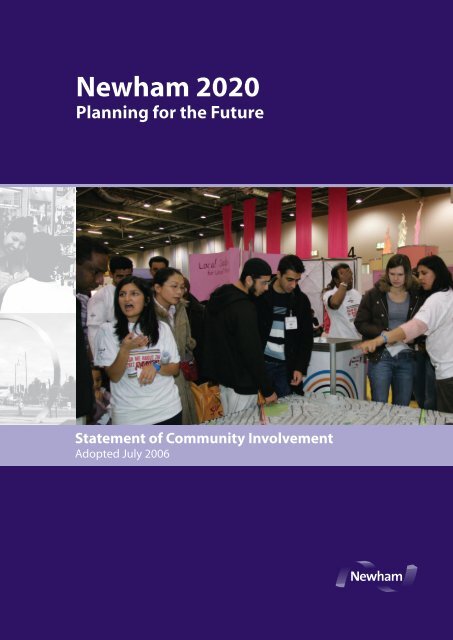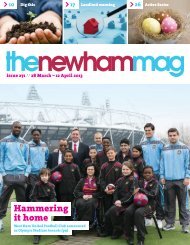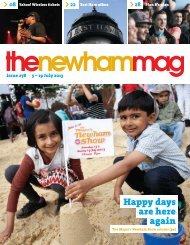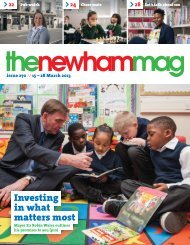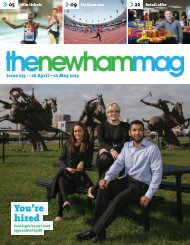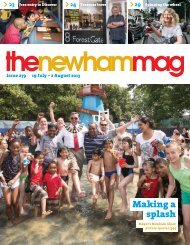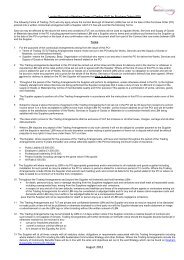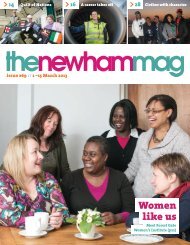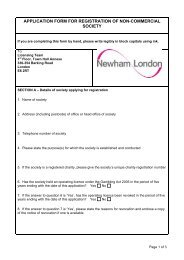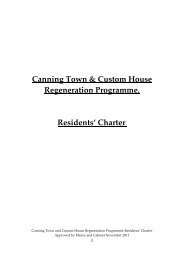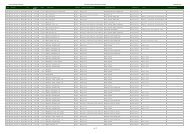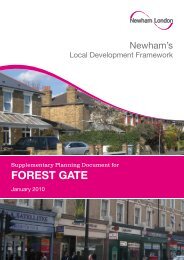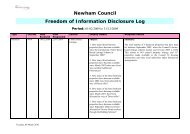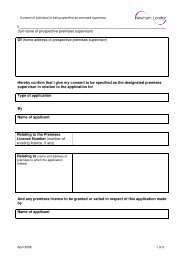Statement of Community Involvement - Newham
Statement of Community Involvement - Newham
Statement of Community Involvement - Newham
You also want an ePaper? Increase the reach of your titles
YUMPU automatically turns print PDFs into web optimized ePapers that Google loves.
<strong>Newham</strong> 2020<br />
Planning for the Future<br />
<strong>Statement</strong> <strong>of</strong> <strong>Community</strong> <strong>Involvement</strong><br />
Adopted July 2006
London Borough <strong>of</strong> <strong>Newham</strong><br />
Local Development Framework<br />
<strong>Statement</strong> <strong>of</strong> <strong>Community</strong><br />
<strong>Involvement</strong><br />
Adopted July 2006<br />
For further information please contact<br />
Planning Policy & Research<br />
Forward Planning & Transportation<br />
London Borough <strong>of</strong> <strong>Newham</strong><br />
Town Hall<br />
High Street South<br />
East Ham<br />
London<br />
E6 2RP<br />
Tel: 020 8430 2000<br />
Email: ldf@newham.gov.uk<br />
Web-site: www.newham.gov.uk/Services/LocalDevelopmentFramework
ii<br />
<strong>Statement</strong> <strong>of</strong> <strong>Community</strong> <strong>Involvement</strong><br />
July 2006
<strong>Statement</strong> <strong>of</strong> <strong>Community</strong> <strong>Involvement</strong><br />
July 2006<br />
Contents<br />
PART ONE: THE LOCAL DEVELOPMENT FRAMEWORK AND<br />
STATEMENT OF COMMUNITY INVOLVEMENT<br />
1. Introduction..................................................................................................... 3<br />
2. The Local Development Framework............................................................... 3<br />
3. The <strong>Statement</strong> <strong>of</strong> <strong>Community</strong> <strong>Involvement</strong>..................................................... 3<br />
4. Current Consultation Commitment – <strong>Newham</strong>’s <strong>Community</strong> Strategy............. 4<br />
PART TWO: NEWHAM PLANNING COMMITMENT TO CONSULTATION<br />
WITH IT'S COMMUNITIES<br />
5. The <strong>Newham</strong> <strong>Community</strong> ............................................................................... 9<br />
6. The Local Development Framework Process ............................................... 11<br />
7. Involving the <strong>Community</strong> in the Local Development Framework Process..... 12<br />
8. Involving the <strong>Community</strong> in the Development Control Process .................... 17<br />
9. Monitoring and Review ................................................................................. 21<br />
APPENDICES<br />
Appendix 1: What the <strong>Statement</strong> <strong>of</strong> <strong>Community</strong> <strong>Involvement</strong> must do .......... 25<br />
Appendix 2: <strong>Newham</strong>’s community pr<strong>of</strong>ile ..................................................... 27<br />
Appendix 3: Minimum requirements for public consultation........................... 29<br />
Appendix 4: Council’s existing community liaison structure........................... 31<br />
Appendix 5: Consultation methods aspiring to full accessibility ................... 35<br />
Appendix 6: London Thames Gateway Development Corporation ................ 37<br />
Appendix 7: Methods <strong>of</strong> consultation ............................................................. 39<br />
Appendix 8: Glossary .................................................................................... 43<br />
Contact us........................................................................................................... 47<br />
iii
iv<br />
<strong>Statement</strong> <strong>of</strong> <strong>Community</strong> <strong>Involvement</strong><br />
July 2006
<strong>Statement</strong> <strong>of</strong> <strong>Community</strong> <strong>Involvement</strong><br />
July 2006<br />
PART ONE<br />
THE LOCAL DEVELOPMENT FRAMEWORK AND<br />
THE STATEMENT OF COMMUNITY INVOLVEMENT<br />
1
2<br />
<strong>Statement</strong> <strong>of</strong> <strong>Community</strong> <strong>Involvement</strong><br />
July 2006
<strong>Statement</strong> <strong>of</strong> <strong>Community</strong> <strong>Involvement</strong><br />
July 2006<br />
1. Introduction<br />
1.1 The purpose <strong>of</strong> this <strong>Statement</strong> <strong>of</strong> <strong>Community</strong> <strong>Involvement</strong> (SCI) is to set<br />
out the Council’s policy for involving the local community in the preparation<br />
<strong>of</strong> planning documents and in decisions on planning applications. The<br />
preparation <strong>of</strong> the SCI is a statutory requirement under the Planning and<br />
Compulsory Purchase Act (2004) and is being led by the Council’s<br />
Planning Policy and Research Team within the Forward Planning and<br />
Transportation Section. Other teams and departments from within the<br />
Council will be involved in key development areas and consultation<br />
exercises where appropriate.<br />
2. The Local Development Framework<br />
2.1 The Planning and Compulsory Purchase Act (2004) introduced a number<br />
<strong>of</strong> changes to the planning system as part <strong>of</strong> the Government’s<br />
commitment to creating sustainable communities and delivering<br />
sustainable development. The major change is the replacement <strong>of</strong> the<br />
current Unitary Development Plan (UDP) with a Local Development<br />
Framework (LDF). The LDF is made up <strong>of</strong> a ‘portfolio’ <strong>of</strong> Local<br />
Development Documents which include:<br />
• Development Plan Documents<br />
• Supplementary Planning Documents<br />
• <strong>Statement</strong> <strong>of</strong> <strong>Community</strong> <strong>Involvement</strong><br />
2.2 These documents must be prepared in consultation with the public. They<br />
will outline what land uses and activities are appropriate to specific<br />
locations within the Borough, and form the basis for the delivery <strong>of</strong> the<br />
Council’s planning service. Full details <strong>of</strong> the Local Development<br />
Framework and the process, timeframes and resourcing implications for<br />
the preparation and implementation <strong>of</strong> the LDF documents are outlined in<br />
the Council’s Local Development Scheme (LDS). A copy <strong>of</strong> the scheme is<br />
available from the Council or can be downloaded from the Planning section<br />
<strong>of</strong> the <strong>Newham</strong> website www.newham.gov.uk.<br />
3. The <strong>Statement</strong> <strong>of</strong> <strong>Community</strong> <strong>Involvement</strong><br />
3.1 The Planning and Compulsory Purchase Act 2004 aims to strengthen<br />
community and stakeholder involvement in the UK planning system and as<br />
such Planning Policy <strong>Statement</strong> 12 – Local Development Frameworks<br />
requires every planning authority to produce a <strong>Statement</strong> <strong>of</strong> <strong>Community</strong><br />
<strong>Involvement</strong> (SCI). The SCI will describe how the community will be<br />
involved in the Local Development Framework (LDF) review process and<br />
3
<strong>Statement</strong> <strong>of</strong> <strong>Community</strong> <strong>Involvement</strong><br />
July 2006<br />
in decisions on planning applications. Full details <strong>of</strong> the requirements <strong>of</strong><br />
the Act (2004) are in Appendix 1.<br />
3.2 The key elements <strong>of</strong> the SCI are:<br />
• Who is the ‘<strong>Newham</strong> community’ to be consulted?<br />
• What methods will the Council use to attempt to reach this community<br />
and involve them in the planning process?<br />
• How and when can the community get involved in the planning process<br />
– the LDF review process and decisions on planning applications?<br />
• How will the Council provide feedback to the community involved?<br />
These elements are addressed in detail in Part Two: Consultation with the<br />
<strong>Newham</strong> community.<br />
4. Current Consultation Commitment – <strong>Newham</strong>’s<br />
<strong>Community</strong> Strategy<br />
4.1 <strong>Community</strong> strategies are wide ranging strategies for community cohesion,<br />
equity and sustainable development and are prepared for each local<br />
authority area by the Local Strategic Partnership. Local Strategic<br />
Partnerships bring together a wide range <strong>of</strong> relevant stakeholders and<br />
community interests to the process and as such these documents are seen<br />
as a substantial indicator <strong>of</strong> community desire and the priorities for<br />
borough improvement.<br />
4.2 <strong>Newham</strong>’s <strong>Community</strong> Strategy (NCS) is the result <strong>of</strong> a great deal <strong>of</strong> local<br />
consultation. It draws on the results <strong>of</strong> a range <strong>of</strong> local surveys and<br />
consultation exercises, including those conducted directly by the Mayor.<br />
The strategy was developed through <strong>Newham</strong> Local Strategic Partnership<br />
meetings and discussions, with the views and comments <strong>of</strong> the<br />
Partnership reflected throughout the document, which also takes account<br />
<strong>of</strong> national government priorities.<br />
4.3 <strong>Newham</strong>’s <strong>Community</strong> Strategy will set the context for the involvement <strong>of</strong><br />
the community and other stakeholders in the Local Development<br />
Framework process, as set out in this <strong>Statement</strong> <strong>of</strong> <strong>Community</strong><br />
<strong>Involvement</strong>. The <strong>Community</strong> Strategy includes headline targets for the<br />
London Borough <strong>of</strong> <strong>Newham</strong> (as outlined below) that will be carried<br />
through in developing the Local Development Framework.<br />
4
<strong>Statement</strong> <strong>of</strong> <strong>Community</strong> <strong>Involvement</strong><br />
July 2006<br />
Headline targets<br />
A better environment for all<br />
To make <strong>Newham</strong> a place where people choose to live and work.<br />
Building an active and inclusive community<br />
Everyone in the borough should have the same chances in life, whatever their<br />
background and <strong>Newham</strong> should be a place where people live harmoniously<br />
and respect each other.<br />
Investing in young people<br />
All our children, whatever their background, to be achieving the same level <strong>of</strong><br />
educational attainment as the national average. They should be healthy with<br />
good career prospects and a good quality <strong>of</strong> life.<br />
Making <strong>Newham</strong> safer<br />
Crime levels in <strong>Newham</strong> to be in line with the London average, and people will<br />
feel safer about living in <strong>Newham</strong>.<br />
Narrowing the health gap<br />
By 2020 the health <strong>of</strong> local people will be at least as good as that <strong>of</strong> people in<br />
the rest <strong>of</strong> London, and by 2010 good progress will have been made towards<br />
achieving this aim.<br />
Business growth and access to jobs<br />
To ensure that <strong>Newham</strong>’s unemployment rate moves in line with the national<br />
average by 2006 and that the income through work <strong>of</strong> <strong>Newham</strong> people<br />
increases to the average level for the surrounding area.<br />
5
6<br />
<strong>Statement</strong> <strong>of</strong> <strong>Community</strong> <strong>Involvement</strong><br />
July 2006
<strong>Statement</strong> <strong>of</strong> <strong>Community</strong> <strong>Involvement</strong><br />
July 2006<br />
PART TWO<br />
NEWHAM PLANNING COMMITMENT TO<br />
CONSULTATION WITH ITS COMMUNITIES<br />
7
8<br />
<strong>Statement</strong> <strong>of</strong> <strong>Community</strong> <strong>Involvement</strong><br />
July 2006
<strong>Statement</strong> <strong>of</strong> <strong>Community</strong> <strong>Involvement</strong><br />
July 2006<br />
5. The <strong>Newham</strong> <strong>Community</strong><br />
5.1 Ensuring full and meaningful public consultation is necessary to meet the<br />
<strong>Newham</strong> <strong>Community</strong> Strategy aspiration to build an active and inclusive<br />
community, and is a key element in the preparation <strong>of</strong> planning documents<br />
within the Local Development Framework and in making decisions on<br />
planning applications.<br />
5.2 It is recognised that <strong>Newham</strong> has a wide range <strong>of</strong> communities (see<br />
Appendix 2 for details) and the Council aspires to involve all <strong>of</strong> these<br />
communities, together with those who live, work or seek entertainment in<br />
the borough, in the process <strong>of</strong> determining how to safeguard, change and<br />
improve the borough.<br />
5.3 The Council aims to ensure that all people within our community have the<br />
opportunity to be involved in the decisions that help shape the future <strong>of</strong> our<br />
borough. The Council wants to ensure that all interested parties are kept<br />
informed and have the opportunity to fully participate in the planning<br />
process. As such the Council will use the most appropriate techniques<br />
available to consult with members <strong>of</strong> the community and aspires to full<br />
accessibility to meetings, consultation events and public documents.<br />
5.4 With regard to involving and engaging specific groups within the<br />
community, the table below details additional support the Council will<br />
provide:<br />
<strong>Community</strong><br />
People who do not<br />
speak English as their<br />
first language<br />
Disabled persons<br />
Youth<br />
People with little prior<br />
knowledge <strong>of</strong> the<br />
planning system<br />
Relevant methods <strong>of</strong> involvement<br />
• Translation panel on all documents<br />
• Documents in a variety <strong>of</strong> languages spoken<br />
and read in the borough provided by the<br />
Language Shop<br />
• Language interpreters at meetings available<br />
on request<br />
• All documents are available in large print,<br />
Braille and Easy Read formats<br />
• All meetings to be held in accessible premises<br />
with induction loop [where premises is not fully<br />
accessible attendees notified]<br />
• Sign language interpretation at meetings<br />
available on request<br />
• <strong>Involvement</strong> <strong>of</strong> the Youth Parliament<br />
• Produce documents in ‘plain English’,<br />
avoiding the use <strong>of</strong> jargon and technical<br />
terminology<br />
• Provide summaries <strong>of</strong> longer documents<br />
• Use <strong>of</strong> public meetings and counter advice for<br />
explanation <strong>of</strong> issues<br />
9
<strong>Statement</strong> <strong>of</strong> <strong>Community</strong> <strong>Involvement</strong><br />
July 2006<br />
It is also noted that bodies representing the interests <strong>of</strong> disabled persons,<br />
youth, elderly, racial, ethnic or national groups and religious groups are<br />
specifically listed for direct consultation throughout the Local Development<br />
Framework. Appendix 5 provides further details on methods <strong>of</strong><br />
consultation aspiring to full accessibility.<br />
5.5 There is a wealth <strong>of</strong> experience in engaging <strong>Newham</strong>’s communities that<br />
exists within the London Borough <strong>of</strong> <strong>Newham</strong> across a variety <strong>of</strong> sectors<br />
that will be drawn on in achieving these goals.<br />
5.6 The minimum requirement for public consultation on the Local<br />
Development Framework is set out in Appendix 3. However, it is<br />
recognised that to achieve the Council’s aspirations <strong>of</strong> greater community<br />
involvement in <strong>Newham</strong> more than this is required. The following sections<br />
outline how we will attempt to involve the wider community in the planning<br />
process (refer to Appendix 4 for the Council’s existing community liaison<br />
structure and Appendix 5 for methods <strong>of</strong> consultation aspiring to full<br />
accessibility).<br />
10
<strong>Statement</strong> <strong>of</strong> <strong>Community</strong> <strong>Involvement</strong><br />
July 2006<br />
6. The Local Development Framework Process<br />
6.1 As outlined in Part One, there is a new system <strong>of</strong> local land use<br />
development plans in the form <strong>of</strong> the Local Development Framework.<br />
There are no changes to the nature <strong>of</strong> development plans – they continue<br />
to perform the same role <strong>of</strong> establishing the preferred or required land use,<br />
areas <strong>of</strong> change, design standards and so on. The preparation <strong>of</strong> the local<br />
development documents under this framework is to be a participatory<br />
process, with the scope <strong>of</strong> community participation set out in this<br />
<strong>Statement</strong> <strong>of</strong> <strong>Community</strong> <strong>Involvement</strong>.<br />
Proposed preparation, consultation and adoption <strong>of</strong> Local Development<br />
Framework documents<br />
Examination in<br />
public 1 Adoption 1<br />
<strong>Statement</strong> <strong>of</strong> <strong>Community</strong> <strong>Involvement</strong> early 2006 mid2006<br />
Core Strategy mid 2007 early 2008<br />
Royals & Thameside West Area Action<br />
Plan<br />
mid 2007 early 2008<br />
Site Specific Allocations Document late 2008 mid 2009<br />
Stratford & Lower Lea Valley Area Action<br />
Plan<br />
late 2008 mid 2009<br />
Joint Waste DPD late 2008 mid 2009<br />
Beckton & Albert Basin Area Action Plan late 2010 mid 2011<br />
Development Control Manual 2 late 2010 mid 2011<br />
Supplementary Planning Documents To be prepared on an on-going<br />
basis. Adoption <strong>of</strong> first SPD<br />
coincides with adoption <strong>of</strong> Core<br />
Strategy<br />
1<br />
This timetable may be subject to change. Refer to the Local Development Scheme<br />
for the current LDF timetable <strong>of</strong> production at www.newham.gov.uk<br />
2 Prepared if considered Core Strategy and SPDs insufficient for development control<br />
purposes<br />
6.2 The Local Development Framework will consist <strong>of</strong> a set <strong>of</strong> Development<br />
Plan Documents, Supplementary Planning Documents and this <strong>Statement</strong><br />
<strong>of</strong> <strong>Community</strong> <strong>Involvement</strong>. The development plan documents that local<br />
planning authorities must prepare are:<br />
• The core strategy<br />
• Site specific allocations <strong>of</strong> land<br />
• Area action plans (can be for specific areas or by topic); and<br />
• The proposals map.<br />
6.3 The versions <strong>of</strong> these documents may change over time and it will be<br />
possible to add or remove these documents from the framework if<br />
necessary. Other development plans that apply to the Borough, including<br />
the London Plan, must also be formally included within the Local<br />
Development Framework.<br />
11
<strong>Statement</strong> <strong>of</strong> <strong>Community</strong> <strong>Involvement</strong><br />
July 2006<br />
7. Involving the <strong>Community</strong> in the Local Development<br />
Framework Process<br />
7.1 The table below indicates how the community can be involved in the<br />
review process for the Local Development Framework documents – both<br />
Development Plan Documents and Supplementary Planning Documents.<br />
The consultation outlined includes both statutory legislative requirements<br />
(Town and Country Planning (Local Development) (England) Regulations<br />
2004) and London Borough <strong>of</strong> <strong>Newham</strong> initiatives.<br />
7.2 All interested parties can be added to the Council’s Local Development<br />
Framework database by contacting Forward Planning and Transport (refer<br />
to Contacts section <strong>of</strong> this document). All contacts on the database will be<br />
kept informed <strong>of</strong> all opportunities to be involved throughout the LDF<br />
process.<br />
Development Plan Documents<br />
1. Scoping: Consultation and evidence gathering<br />
on possible issues and options<br />
Draft Sustainability<br />
Appraisal scoping report<br />
• Ongoing consultation with specific and general consultation bodies<br />
• Discussions with key stakeholders<br />
• Informal internal consultation<br />
2. Prepare and publish the Issues and Options<br />
report<br />
Assess Issues and<br />
Options against SA<br />
scoping report<br />
Pre-submission consultation (Reg 25)<br />
• Ongoing consultation with specific and general consultation bodies<br />
• Internal circulation <strong>of</strong> papers<br />
• Establish Officers steering group to oversee review process<br />
• Consider establishment <strong>of</strong> Members steering group<br />
• Focussed consultation with LSP, <strong>Community</strong> Board, <strong>Community</strong><br />
Forums, thematic groups<br />
3. Prepare and publish the Preferred Options<br />
report<br />
Initial Sustainability<br />
Appraisal report<br />
Six week formal consultation period (Reg 27)<br />
• Document publicised in accordance with Reg 26:<br />
- Documents and summary documents available at local service<br />
centres, libraries and www.newham.gov.uk<br />
- Copies <strong>of</strong> documents forwarded to statutory consultees (listed in<br />
Appendix 3)<br />
- Give notice by local advertisement<br />
12
<strong>Statement</strong> <strong>of</strong> <strong>Community</strong> <strong>Involvement</strong><br />
July 2006<br />
• Letters and mailshots to key stakeholders and LDF consultees database<br />
• Publicity in local press<br />
• Seek comments and contributions on issues from Members and<br />
stakeholders through Local Strategic Partnership, <strong>Community</strong> Forums,<br />
Mayors Commissions and thematic groups<br />
• Hold public exhibitions and/or meetings in key areas<br />
• Hold thematic meetings where required inviting specialist bodies and<br />
interest groups to be involved. These meetings will be advertised and<br />
open to the general public.<br />
• Meet with consultees who have significant objections using one-to-one<br />
meetings where appropriate<br />
• Provide information to local schools and colleges<br />
4. Prepare submission DPD Draft Final Sustainability<br />
Appraisal report<br />
• On-going consultation with stakeholders and community if necessary<br />
5. Submit DPD to Government for independent<br />
examination<br />
Final Sustainability<br />
Appraisal report<br />
Six week formal consultation period (Reg 29)<br />
• Document submitted to Secretary <strong>of</strong> State and publicised in accordance<br />
with Reg 26:<br />
- Documents and summary documents available at local service<br />
centres, libraries and www.newham.gov.uk<br />
- Copies <strong>of</strong> documents forwarded to statutory consultees (listed in<br />
Appendix 3)<br />
- Give notice by local advertisement<br />
• Notification to anybody who requested to be notified <strong>of</strong> the submission<br />
(Reg 28)<br />
6. Consultation on alternate sites (Reg 33)<br />
• Representations received in respect <strong>of</strong> site allocations to be publicised<br />
in accordance with Reg 26 (as above) (Reg 32)<br />
• A further period <strong>of</strong> six weeks allowed for comments to be submitted in<br />
respect <strong>of</strong> the site allocation representations (Reg 33)<br />
• Letters and mailshots to key stakeholders and LDF consultees database<br />
7. Independent examination <strong>of</strong> DPD before an Inspector<br />
• Notify all bodies who made representations <strong>of</strong> the details for the<br />
examination at least six weeks before the examination (Reg 34)<br />
• Advertise details <strong>of</strong> the examination in the local press and<br />
www.newham.gov.uk (Reg 34)<br />
13
<strong>Statement</strong> <strong>of</strong> <strong>Community</strong> <strong>Involvement</strong><br />
July 2006<br />
8. Adoption <strong>of</strong> the DPD into the Local Development Framework<br />
• Inspectors report available at local service centres, libraries and<br />
www.newham.gov.uk and notification given to those that requested it<br />
(Reg 35)<br />
• Adopted DPD and all associated documents available for inspection at<br />
local service centres, libraries and www.newham.gov.uk<br />
• All consultees and other bodies involved in the preparation <strong>of</strong> the DPD<br />
advised that it has been adopted.<br />
Supplementary Planning Documents<br />
1. Preparation <strong>of</strong> draft SPD<br />
Assess against SA<br />
scoping report<br />
• Ongoing consultation with specific and general consultation bodies<br />
• Discussions with key stakeholders<br />
• Internal consultation<br />
2. Public consultation on draft SPD<br />
Sustainability Appraisal<br />
report<br />
Six week formal consultation period (Reg 18)<br />
• Document publicised in accordance with Reg 17:<br />
- Documents and summary documents available at local service<br />
centres, libraries and www.newham.gov.uk<br />
- Copies <strong>of</strong> documents forwarded to statutory consultees (listed in<br />
Appendix 3)<br />
• Letters and mailshots to key stakeholders and LDF consultees database<br />
• Seek comments and contributions on issues from Members and<br />
stakeholders through Local Strategic Partnership, <strong>Community</strong> Forums,<br />
Mayors Commissions and thematic groups<br />
3. Adoption <strong>of</strong> SPD<br />
• Adopted SPD and all associated documents available for inspection at<br />
local service centres, libraries and www.newham.gov.uk (Reg 19)<br />
• Adoption statement forwarded to those that requested it (Reg 19)<br />
• All consultees and other bodies involved in the preparation <strong>of</strong> the SPD<br />
advised that it has been adopted.<br />
Sustainability appraisal – Strategic Environmental Assessment<br />
7.3 European Directive 2001/42/EC ‘The Assessment <strong>of</strong> the effects <strong>of</strong> certain<br />
plans and programmes on the environment’ requires that a Strategic<br />
Environmental Assessment (SEA) is carried out for all relevant plans and<br />
programmes.<br />
14
<strong>Statement</strong> <strong>of</strong> <strong>Community</strong> <strong>Involvement</strong><br />
July 2006<br />
7.4 The Government has implemented this Directive through the<br />
‘Environmental Assessment <strong>of</strong> Plans and Programmes Regulations 2004’.<br />
In order to meet this requirement, Local Development Documents must be<br />
assessed using a process <strong>of</strong> ‘Sustainability Appraisal’.<br />
7.5 The assessment is similar to that used for the Sustainability Appraisal <strong>of</strong><br />
the <strong>Newham</strong> Unitary Development Plan 2001, but is now a more in-depth<br />
examination <strong>of</strong> the environmental, social and economic impacts <strong>of</strong> the<br />
LDD. It is required that the assessment is carried out from the start <strong>of</strong> the<br />
document creation or review, and that it informs and shapes the direction<br />
that options, policies and designations take in the final document.<br />
7.6 Local Development Documents will be subject to an assessment <strong>of</strong> the key<br />
policies and proposals against an agreed set <strong>of</strong> environmental, social and<br />
economic objectives (the SEA/SA objectives). Full details <strong>of</strong> these<br />
objectives are in the report Strategic Environmental Assessment (SEA)/<br />
Sustainability Appraisal (SA) <strong>of</strong> <strong>Newham</strong> Local Development Framework –<br />
Initial SA Report (Scott Wilson Business Consultancy, March 2005). The<br />
final result <strong>of</strong> the assessment is a ‘Sustainability Report’ on the adopted<br />
Local Development Framework, which will form the basis for monitoring<br />
and review.<br />
7.7 The Sustainability Appraisal report will be made available at the key public<br />
intervention points identified above. Given the complexities and technical<br />
nature <strong>of</strong> Sustainability Appraisals, consultation is likely to be targeted<br />
toward statutory environmental agencies and stakeholders with a<br />
sustainability or environmental focus. Comments received on these<br />
findings will improve the sustainability credentials <strong>of</strong> each document.<br />
Providing feedback on consultation<br />
7.8 The tables above show that community consultation is required at various<br />
stages throughout the preparation <strong>of</strong> Local Development Documents. The<br />
stages <strong>of</strong> formal consultation for Development Plan Documents are at<br />
Stage 3 (Preferred Options Report) and Stage 5 (submission <strong>of</strong> the DPD<br />
for independent examination). For Supplementary Planning Documents<br />
(non-statutory documents) the one period <strong>of</strong> formal community<br />
engagement is at Stage 2.<br />
7.9 At the conclusion <strong>of</strong> each formal consultation period, a Consultation<br />
<strong>Statement</strong> will be prepared. The statement will set out:<br />
• who was consulted pursuant to regulation 25(1);<br />
• how they were consulted;<br />
• the total number <strong>of</strong> representations made;<br />
• copies <strong>of</strong> all the representations;<br />
• a summary <strong>of</strong> the main issues raised; and<br />
• how these main issues have been addressed in the Local Development<br />
Document.<br />
15
<strong>Statement</strong> <strong>of</strong> <strong>Community</strong> <strong>Involvement</strong><br />
July 2006<br />
7.10 The Consultation <strong>Statement</strong> will be sent to all those who made<br />
representations and will be available for public inspection at local service<br />
centres, libraries and www.newham.gov.uk as soon as practicable after the<br />
formal consultation period has ended.<br />
7.11 For other consultation initiatives throughout the process (as outlined in the<br />
tables above), the London Borough <strong>of</strong> <strong>Newham</strong> will provide feedback to<br />
participants on how their views were taken into account. The format <strong>of</strong> this<br />
feedback will be tailored to each situation.<br />
16
<strong>Statement</strong> <strong>of</strong> <strong>Community</strong> <strong>Involvement</strong><br />
July 2006<br />
8. Involving the <strong>Community</strong> in the Development<br />
Control Process<br />
8.1 The Development Control process is the means by which developers seek<br />
approval from the local planning authority for development proposals.<br />
‘Development’ includes changes to the use <strong>of</strong> a building, construction <strong>of</strong> a<br />
new building, extensions to an existing building, certain categories <strong>of</strong><br />
engineering works, display <strong>of</strong> advertisements, erection <strong>of</strong> telephone masts<br />
and works to trees. There are specific regulations related to the work that<br />
can be carried out to listed buildings, buildings in conservation areas and<br />
protected trees.<br />
8.2 The London Borough <strong>of</strong> <strong>Newham</strong> is the local planning authority for<br />
development in <strong>Newham</strong>. In addition, the London Thames Gateway<br />
Development Corporation (established May 2004) is the local planning<br />
authority for applications relevant to its purpose <strong>of</strong> sustainable<br />
regeneration in East London – major strategic applications within the area<br />
that it covers. The kinds <strong>of</strong> development within the London Thames<br />
Gateway Development Corporation (LTGDC) boundary that will be<br />
determined by the LTGDC are listed on the planning page <strong>of</strong> their website<br />
at www.ltgdc.org.uk/planning.<br />
8.3 The LTGDC covers the following parts <strong>of</strong> <strong>Newham</strong> – East Beckton,<br />
Canning Town and the Lea Valley including the area to the West <strong>of</strong><br />
Silvertown Way and south <strong>of</strong> the North Woolwich Road (the ‘Riverside<br />
Industrial Belt’) as far as Thames Barrier Park. The area does not include<br />
the Silvertown Quays development or the development lands adjoining the<br />
Royal Albert and King George V Docks. Refer to Appendix 6 for a map <strong>of</strong><br />
the LTGDC boundary.<br />
8.4 Applicants are encouraged to liaise with the Council (and the LTGDC<br />
where appropriate) and the local community when preparing their<br />
development proposal, particularly for larger schemes. These preapplication<br />
discussions will help establish the level <strong>of</strong> consultation<br />
considered suitable for the proposal and will identify key community issues<br />
at an early stage. If an applicant undertakes consultation before<br />
submitting an application a full consultation report detailing the methods <strong>of</strong><br />
consultation and the people reached should be submitted with the<br />
application.<br />
8.5 The Council is required to meet the statutory minimum requirements for<br />
consultation as set out in the Town and Country Planning (General<br />
Development Procedure) Order 1995. On receipt <strong>of</strong> a valid application the<br />
Council will:<br />
• Notify adjacent neighbours and other affected parties in writing<br />
17
<strong>Statement</strong> <strong>of</strong> <strong>Community</strong> <strong>Involvement</strong><br />
July 2006<br />
• Make all applications available for inspection at the Development<br />
Control Reception (Town Hall Annexe, East Ham) 1<br />
• List all applications (and details <strong>of</strong> decisions) at the Town Hall, local<br />
service centres, borough libraries and on the Council website<br />
• Most applications are advertised in the <strong>Newham</strong> Recorder and/or on<br />
site.<br />
8.6 Upon notification <strong>of</strong> the application those consulted have 21 days, or for<br />
English Nature 28 days in the case <strong>of</strong> a planning application potentially<br />
affecting a SSSI or in a SSSI conservation area 2 , in which to comment.<br />
Comments received are considered by the case <strong>of</strong>ficer in recommending<br />
an application for approval or refusal <strong>of</strong> planning permission. All those<br />
who submit comments on a planning application will be advised in writing<br />
<strong>of</strong> the decision made.<br />
8.7 For most applications the above procedure <strong>of</strong> public consultation is<br />
sufficient. On applications that the Council considers to be major<br />
development further consultation will be required. For these applications<br />
the Council suggests a tiered approach to consultation – the tiers identified<br />
have increased consultation requirements for developments that are more<br />
controversial or less compliant with the provisions <strong>of</strong> the Local<br />
Development Framework.<br />
Potential methods <strong>of</strong> consultation at each ‘tier’ <strong>of</strong> application<br />
Approach Tier 1 Tier 2 Tier 3<br />
Public meeting<br />
<br />
Public exhibition <br />
Surgeries <br />
Development briefs<br />
<br />
Workshops<br />
<br />
Enquiry by design and/or Planning for<br />
real<br />
<br />
Citizen panels <br />
Consultation groups<br />
<br />
Parish councils <br />
Media <br />
Website <br />
Local architectural or design panel <br />
Planning aid <br />
1 Consultees that are a Blue Badge Holder can have application details posted to their<br />
home address. If a meeting with the planning <strong>of</strong>ficer is required a home visit will be<br />
<strong>of</strong>fered.<br />
2 In accordance with Section 28 <strong>of</strong> the Wildlife and Countryside Act 1981 as amended by<br />
Section 75 and Schedule 9 <strong>of</strong> the Countryside and Rights <strong>of</strong> Way Act 2000.<br />
18
<strong>Statement</strong> <strong>of</strong> <strong>Community</strong> <strong>Involvement</strong><br />
July 2006<br />
Tier 1<br />
Tier 2<br />
Tier 3<br />
Applications where there are considerable issues <strong>of</strong> scale and<br />
controversy or contrary to or out <strong>of</strong> line with Development Plan<br />
(Local Development Framework or Area Action Plan) policy.<br />
Applications broadly in accordance with the Development Plan<br />
BUT raising controversial issue or detail.<br />
Applications <strong>of</strong> a scale or development area for which the Council<br />
requires wider community involvement; applications that fall<br />
within sites that are ‘sensitive’ to development pressures and<br />
allocated sites that may not have been subject to previous<br />
extensive consultation<br />
It is noted that the table is indicative only as to the methods <strong>of</strong> community<br />
engagement that may be appropriate at each level. Appendix 7 provides<br />
detail <strong>of</strong> the indicated approaches.<br />
8.8 Major applications are discussed at the Development Control Committee<br />
meeting <strong>of</strong> Council, where Members make the decision on the application.<br />
This is a public meeting and any person consulted on the application that<br />
responded to the Council in writing will be given the opportunity to speak at<br />
the meeting. All submitters will be advised in writing <strong>of</strong> the decision made.<br />
The decisions reached by the Development Control Committee are also<br />
publicly available from the Town Hall, local service centres, borough<br />
libraries and the Council website www.newham.gov.uk.<br />
8.9 Major planning applications within the LTGDC area will be determined by<br />
the LTGDC Planning Committee. Consultation on such applications will be<br />
in accordance with the protocol for consultation established between the<br />
LTGDC and London Borough <strong>of</strong> <strong>Newham</strong>. The LTGDC Planning<br />
Committee meetings are open to the public and it will be possible for<br />
parties with a specific interest in an application to address the committee.<br />
Details <strong>of</strong> the LTGDC Planning Committee can be found on the LTGDC<br />
website www.ltgdc.org.uk.<br />
8.10 For developments that require an Environmental Impact Assessment, the<br />
developer may be required to engage with the local community as part <strong>of</strong><br />
the process <strong>of</strong> determining community facilities and improvements<br />
required in order to mitigate effects <strong>of</strong> the proposed development.<br />
Telecommunications applications include particular requirements for<br />
developers to liaise with local schools and communities.<br />
The appeal process<br />
8.11 Where the Council refuses a planning application, the applicant may<br />
appeal the decision within 6 months <strong>of</strong> the decision date. Any person<br />
previously consulted and objectors to the original application will be<br />
notified by the Council <strong>of</strong> the appeal, and given the opportunity to submit<br />
new representation (either in support or opposition) to the Planning<br />
Inspector hearing the case. All appeals and subsequent decisions are<br />
19
<strong>Statement</strong> <strong>of</strong> <strong>Community</strong> <strong>Involvement</strong><br />
July 2006<br />
listed in the Town Hall, Local Service Centres and Libraries and advertised<br />
on the Council website.<br />
Providing guidance on the process<br />
8.12 Applicants themselves are members <strong>of</strong> the community. The Council<br />
produces guidance for applicants on how to make a planning application<br />
(refer to 'Making a Planning Application’ available from the Development<br />
Control team). Development Control <strong>of</strong>ficers can also <strong>of</strong>fer one-to-one<br />
assistance to applicants if required.<br />
8.13 The ‘Development Control Charter’ outlines the planning process and how<br />
Development Control deal with applications. A copy <strong>of</strong> the charter is<br />
available from the Development Control team.<br />
8.14 Planning Aid for London is a registered charity that provides free and<br />
affordable independent planning advice to those who would otherwise be<br />
unable to access the planning system. Planning Aid for London operate a<br />
variety <strong>of</strong> planning services. For further information contact Planning Aid<br />
for London at:<br />
Planning Aid for London<br />
Unit 2, 11-29 Fashion Street<br />
London E1 7QX<br />
Tel. 020 7247 4900<br />
info@planningaidforlondon.org.uk<br />
www.pafl.org.uk<br />
Notification <strong>of</strong> unlawful development<br />
8.15 If you contact the Council regarding potential unlawful development in the<br />
borough, we will acknowledge your information within 3 days and respond<br />
concerning the validity <strong>of</strong> the development being unlawful within a further 5<br />
days. If this is not possible we will contact you and let you know why.<br />
General Development Control enquiries<br />
8.16 General queries to the Development Control team will be dealt with<br />
immediately by the duty planning <strong>of</strong>ficer. Should you leave a message,<br />
send a letter or email you will hear back from us within 3 working days.<br />
For such queries contact the Development Control team at the address at<br />
the end <strong>of</strong> this document.<br />
Complaint’s process<br />
8.17 Should you have a complaint about any component <strong>of</strong> the Development<br />
Control service, you must address your complaint in writing to the Head <strong>of</strong><br />
Development Control at the address indicated at the end <strong>of</strong> the document.<br />
Complaints received will be acknowledged within 3 days, and a full<br />
20
<strong>Statement</strong> <strong>of</strong> <strong>Community</strong> <strong>Involvement</strong><br />
July 2006<br />
response or progress report will be sent within 10 days. If you are<br />
unhappy with the way the complaint was treated contact the Departmental<br />
Complaints Officer, Peter Bone, Environment Department, 25 Nelson<br />
Street, East Ham London E6 2RP.<br />
9. Monitoring and Review<br />
9.1 The effectiveness <strong>of</strong> the <strong>Statement</strong> <strong>of</strong> <strong>Community</strong> <strong>Involvement</strong> will be<br />
monitored and reported on as part <strong>of</strong> the Local Development Framework<br />
Annual Monitoring report. The report will examine whether or not the<br />
Council has met the consultation requirements as outlined in this SCI. The<br />
Council will also monitor the effectiveness <strong>of</strong> consultation by asking for<br />
feedback from those consulted, including asking how the process could be<br />
improved.<br />
9.2 If the monitoring process indicates that the provisions for consultation, as<br />
set out in this SCI are not being achieved, a review <strong>of</strong> the SCI will be<br />
required.<br />
10. Resource Implications<br />
10.1 The preparation <strong>of</strong> the Local Development Framework is being led by the<br />
Planning Policy and Research team within the Forward Planning and<br />
Transportation section.<br />
10.2 The current team structure is:<br />
Forward Planning & Transportation – Policy & Research Team<br />
Group Leader<br />
3.5 x Principal Planners<br />
1 x Principal Research Officer<br />
3 x Planners<br />
2 x Trainee Planners<br />
10.3 The specific staff allocation for the preparation <strong>of</strong> the Local Development<br />
Framework documents is outlined in Appendix 1 <strong>of</strong> the Local Development<br />
Scheme. All team members will participate in tasks relating to public<br />
consultation and discussions with other key stakeholders.<br />
10.4 We will also utilise other staff resources from within Forward Planning and<br />
Transportation (including administration and graphics staff) in carrying out<br />
consultation exercises. Staff from other Council service areas will make<br />
specific contributions to the Local Development Framework process,<br />
including Regeneration, Projects, Development Control, Culture and<br />
21
<strong>Statement</strong> <strong>of</strong> <strong>Community</strong> <strong>Involvement</strong><br />
July 2006<br />
<strong>Community</strong>, Communications and the Language Shop. The use <strong>of</strong><br />
specialist consultancy services will be utilised where this is considered<br />
necessary and will add value to a particular consultation process.<br />
22
<strong>Statement</strong> <strong>of</strong> <strong>Community</strong> <strong>Involvement</strong><br />
July 2006<br />
APPENDICES<br />
23
24<br />
<strong>Statement</strong> <strong>of</strong> <strong>Community</strong> <strong>Involvement</strong><br />
July 2006
<strong>Statement</strong> <strong>of</strong> <strong>Community</strong> <strong>Involvement</strong><br />
July 2006<br />
Appendix 1: What the <strong>Statement</strong> <strong>of</strong> <strong>Community</strong><br />
<strong>Involvement</strong> must do<br />
Planning and Compulsory Purchase Act 2004<br />
The Act aims to strengthen community and stakeholder involvement in planning<br />
system. The <strong>Statement</strong> <strong>of</strong> <strong>Community</strong> <strong>Involvement</strong> will set out the intended<br />
approach to involving stakeholders and community members in the Local<br />
Development Framework preparation and significant development control<br />
decisions.<br />
The minimum community involvement is outlined in the requirements <strong>of</strong> the Town<br />
and Country Planning (Local Development) (England) Regulations 2004.<br />
‘Creating Local Development Frameworks’ (ODPM, 2004) it is indicated that<br />
community and stakeholder involvement will involve some or all <strong>of</strong> the following<br />
principles and benefits:<br />
• A structured approach to managing community involvement based on an<br />
analysis <strong>of</strong> stakeholder and community interests<br />
• Clear and effective communication, including identifying when and how to<br />
involve stakeholders and the community in the planning process. As such the<br />
planning process should be clear and transparent<br />
• Strengthening the evidence base – Stakeholders and community involvement<br />
should be valued for their opinions, insights and expertise<br />
• Capacity Building – and a proactive approach - it may be necessary to provide<br />
training, briefing sessions or access to independent advice<br />
• Strengthening Delivery – a spatial plan may be delivered by a wider range <strong>of</strong><br />
agencies than just Planning – the community may, it could be found, be able to<br />
help with delivery<br />
• Addressing Difficult Decisions – using the community to ensure plans and the<br />
decision making process address real issues<br />
• Focused staff and resources – managing participation can be resource<br />
intensive so the approach must be targeted and realistic<br />
• Fitness for purpose approach – different approaches to securing community<br />
involvement should be deployed in relation to different frameworks and at<br />
different stages. In particular the range <strong>of</strong> organisations will vary. The<br />
objectives <strong>of</strong> community involvement must be assessed at each stage e.g.<br />
whether it is to strengthen the evidence base, build consensus, secure<br />
commitment to delivery or something else.<br />
There should be clearly articulated opportunities for continuing involvement. The<br />
benefits <strong>of</strong> community and stakeholder involvement include:<br />
• <strong>Community</strong> commitment to the future development <strong>of</strong> the area<br />
• Means <strong>of</strong> effectively co-ordinating the activities <strong>of</strong> different departments and<br />
organisations<br />
• Promoting regeneration and investment, creating certainty and commitment to<br />
change<br />
• Providing a strong basis for successful negotiations on development<br />
proposals including developer contributions<br />
25
• Providing a robust basis for addressing difficult decisions.<br />
<strong>Statement</strong> <strong>of</strong> <strong>Community</strong> <strong>Involvement</strong><br />
July 2006<br />
A key component <strong>of</strong> the <strong>Statement</strong> <strong>of</strong> <strong>Community</strong> <strong>Involvement</strong> is that it must be<br />
‘front loaded’ – involvement <strong>of</strong> the community and stakeholders as early as<br />
possible so as to:<br />
a. enable communities to set the agenda – not just get involved to approve an<br />
agenda set by others; and<br />
b. enable conflicts and challenges to be identified as early as possible so as to<br />
allow maximum time for solutions to be found before they have to go through<br />
the formal public inquiry process.<br />
By indicating that community involvement is important we are encouraging<br />
awareness <strong>of</strong> the value <strong>of</strong> such involvement. This is the key role <strong>of</strong> the <strong>Statement</strong><br />
<strong>of</strong> <strong>Community</strong> <strong>Involvement</strong> – encouraging clarity and transparency and so<br />
encouraging a speeding up <strong>of</strong> the planning process. By ‘front ending’ the<br />
awareness <strong>of</strong> conflicting interests or needs it is hoped solutions can be found<br />
earlier, potentially avoiding the time and costs associated with a public or local<br />
inquiry.<br />
Other legislation and guidance<br />
The Race Relations (Amendment) Act 2000 created a general duty to promote<br />
race equality, eliminate unlawful race discrimination and promote equality <strong>of</strong><br />
opportunity and good relations between persons <strong>of</strong> different racial groups.<br />
<strong>Community</strong> involvement encourages people regardless <strong>of</strong> background to assess<br />
their area and let people know how the area if failing them.<br />
The Disability Discrimination Act 1995 places a duty on those responsible for<br />
providing a service to the public not to discriminate against disabled people by<br />
providing a lower standard <strong>of</strong> service and for providers to make reasonable<br />
adjustments to the way they deliver their service so that disabled people can use<br />
them. There is also a duty on public bodies to promote disability equality.<br />
<strong>Community</strong> involvement encourages people regardless <strong>of</strong> background to assess<br />
their area and let people know how the area if failing them, including on grounds<br />
<strong>of</strong> disability.<br />
The Human Rights Act 1998 requires that amongst others, people’s property<br />
rights are recognised and respected. <strong>Community</strong> involvement makes it more<br />
likely we get a full picture as to what property/ space needs people have or need<br />
and make decisions accordingly.<br />
In the Office <strong>of</strong> the Deputy Prime Minister document ‘<strong>Community</strong> <strong>Involvement</strong> in<br />
Planning’ (March 2004), this <strong>Statement</strong> <strong>of</strong> <strong>Community</strong> <strong>Involvement</strong> and<br />
community involvement requirements are consistent with the wider Government<br />
aim 3 <strong>of</strong> getting people involved in how their communities are shaped.<br />
3 For example the Government White Papers ‘Modernising Local Government: In Touch<br />
with Local People’ (1998) and ‘Our Towns and Cities: The Future’ (2000).<br />
26
<strong>Statement</strong> <strong>of</strong> <strong>Community</strong> <strong>Involvement</strong><br />
July 2006<br />
Appendix 2: <strong>Newham</strong>’s community pr<strong>of</strong>ile<br />
<strong>Newham</strong> has one <strong>of</strong> the most culturally diverse communities in the country with a<br />
much younger age pr<strong>of</strong>ile than nationally. <strong>Newham</strong> is a dynamic and continually<br />
evolving and improving borough. Generally linked with depravation and poverty,<br />
<strong>Newham</strong> is moving away from this cycle to become a place where people choose<br />
to live and work.<br />
The population <strong>of</strong> <strong>Newham</strong> is currently estimated at 250,600 residents, although<br />
this is projected to increase by up to 90,000 in the next 15–20 years,<br />
predominantly due to new development in the ‘Arc <strong>of</strong> Opportunity’.<br />
<strong>Newham</strong> has a higher proportion <strong>of</strong> younger people and a lower proportion <strong>of</strong><br />
older people than London, with population estimates by age showing 40% are<br />
under the age <strong>of</strong> 25.<br />
With almost two-thirds (61%) <strong>of</strong> the population being from Mixed, Asian or Asian<br />
British, Black or Black British, Chinese or other ethnic groups, <strong>Newham</strong> has the<br />
largest proportion <strong>of</strong> non-White ethnic groups in England and Wales. <strong>Newham</strong><br />
has the second highest percentage <strong>of</strong> Asians in England and Wales, and the<br />
second highest percentage <strong>of</strong> Black Africans in England and Wales. The various<br />
ethnic groups are concentrated in different parts <strong>of</strong> the borough.<br />
The 2001 Census figures show that <strong>Newham</strong> has the second largest percentage<br />
<strong>of</strong> Muslims (24.3% <strong>of</strong> <strong>Newham</strong> residents) in England in Wales, and the fourth<br />
lowest percentage <strong>of</strong> Christians (46.8%).<br />
<strong>Newham</strong> has a higher number <strong>of</strong> asylum seekers compared with other London<br />
boroughs (second largest number <strong>of</strong> asylum seekers). The asylum population in<br />
<strong>Newham</strong> constitute less than one percent <strong>of</strong> the total population.<br />
<strong>Newham</strong> has one <strong>of</strong> the poorest communities in the country. The <strong>Newham</strong><br />
Household Panel Survey (2004) calculated that around 45% <strong>of</strong> the population<br />
were in poverty 4 . Using the Indices <strong>of</strong> Deprivation 2004 (a measure <strong>of</strong> multiple<br />
deprivation at small area level), <strong>Newham</strong> is the eleventh most deprived area in<br />
England and Wales, and the fourth most deprived borough in London.<br />
<strong>Newham</strong> has the highest proportion (37.5%) <strong>of</strong> households with dependent<br />
children in England and Wales, with 15.7% <strong>of</strong> households being lone parent<br />
households (with either dependent or non-dependent children). The average<br />
household size in <strong>Newham</strong> is 2.6 persons per household, the highest for all<br />
London boroughs.<br />
4 <strong>Newham</strong> Household Panel Survey: Household Income, Poverty and Deprivation. Wave<br />
Two Research Report, 2004.<br />
‘Poverty’ is calculated at household income below 60% <strong>of</strong> the median national income.<br />
27
<strong>Statement</strong> <strong>of</strong> <strong>Community</strong> <strong>Involvement</strong><br />
July 2006<br />
Compared with other London boroughs, <strong>Newham</strong> has the lowest proportion <strong>of</strong> its<br />
working age population in employment, with unemployment currently at 7.7%<br />
(compared with 7.1% for London and 4.8% for England and Wales). There is a<br />
higher proportion <strong>of</strong> the working age population who are full-time students<br />
compared with London as a whole, reflecting the youthfulness <strong>of</strong> the population.<br />
The largest employing industry for <strong>Newham</strong>’s employed residents is the<br />
wholesale and retail trade, followed by real estate and business activities, health<br />
and social work, are transport, storage and communication. Only 17% <strong>of</strong> people<br />
in <strong>Newham</strong> are employed in the financial and business services sectors<br />
compared with 43% for East London.<br />
Life expectancy in <strong>Newham</strong> has increased, though it remains lower than the<br />
national average for both males and females. Other health indicators such as<br />
mortality statistics show that <strong>Newham</strong> is below the national average, however the<br />
gap is slowly decreasing. The Census 2002 reported that approximately 26,000<br />
people in <strong>Newham</strong> live with a long term limiting illness. Projections estimate that<br />
the number <strong>of</strong> adults (aged 16 to 64) with disabilities in <strong>Newham</strong> will increase by<br />
almost 11.6% between 1998 and 2011, whereas the number <strong>of</strong> older people with<br />
disabilities (aged 65 or over) will decrease by 2.2%. The estimates are adjusted<br />
to account for the generally higher rates <strong>of</strong> limiting long term illness in <strong>Newham</strong><br />
compared with national rates.<br />
The projected increase in the number <strong>of</strong> households and residents in <strong>Newham</strong><br />
will lead to increased pressures on the boroughs existing leisure facilities, and<br />
create greater demand for new facilities. The Council is committed to enhancing<br />
the range and quality <strong>of</strong> existing sports, arts, cultural, entertainment and heritage<br />
facilities, while encouraging the development <strong>of</strong> new facilities particularly in areas<br />
<strong>of</strong> deficiency. The provision <strong>of</strong> a wide range <strong>of</strong> high quality leisure, tourism and<br />
sporting experiences will encourage people to choose to live, work and visit the<br />
borough.<br />
Source: Focus on <strong>Newham</strong>: Local people and local conditions 2005 (London<br />
Borough <strong>of</strong> <strong>Newham</strong>)<br />
28
<strong>Statement</strong> <strong>of</strong> <strong>Community</strong> <strong>Involvement</strong><br />
July 2006<br />
Appendix 3: Minimum requirements for public<br />
consultation<br />
The Town and Country Planning (Local Development) (England) Regulations<br />
2004 require the following bodies are consulted with regard to the preparation <strong>of</strong><br />
the Local Development Framework:<br />
• The Mayor <strong>of</strong> London<br />
• London Development Agency<br />
• London Thames Gateway Development Corporation<br />
• Adjoining Local Authorities<br />
• The Environment Agency<br />
• English Nature<br />
• Historic Buildings and Monuments Commission for England<br />
• Network Rail<br />
• Relevant Telecommunications Companies<br />
• North East London Health Authority<br />
• Relevant electricity and gas companies<br />
• Thames Water<br />
• North East London Waste Authority<br />
• Highways Agency<br />
Statutory consultees will be consulted on all Local Development Framework<br />
documents, as listed in Chapter 6.<br />
It is also suggested that the following are also consulted:<br />
• Voluntary bodies<br />
• Bodies representing the interests <strong>of</strong> youth, elderly, racial, ethnic or national<br />
groups<br />
• Different religious groups<br />
• Groups representing the interests <strong>of</strong> disabled persons<br />
• Local businesses and bodies representing the interests <strong>of</strong> persons carrying<br />
out business in the area<br />
29
30<br />
<strong>Statement</strong> <strong>of</strong> <strong>Community</strong> <strong>Involvement</strong><br />
July 2006
<strong>Statement</strong> <strong>of</strong> <strong>Community</strong> <strong>Involvement</strong><br />
July 2006<br />
Appendix 4: Council’s existing community liaison<br />
structure<br />
The Council’s democratically elected representatives including the Mayor,<br />
Cabinet and the full Council make decisions at public meetings, <strong>of</strong> which the<br />
records are also publicly available. Mayoral decisions are scrutinised by an<br />
Overview and Scrutiny Committee.<br />
The Council has established mechanisms for involving the community in<br />
decisions about how the borough is managed and can be improved.<br />
The Council, together with local police, education and health providers have<br />
established a Local Strategic Partnership currently looking at health and<br />
wellbeing, prevention <strong>of</strong> crime and antisocial behaviour, environment and<br />
housing, employment, culture and social regeneration and young people. The<br />
following thematic working groups are established under this Partnership – Local<br />
Action Partnership Boards – and include community representatives and members<br />
<strong>of</strong> the voluntary and pr<strong>of</strong>essional sectors working in the borough:<br />
• <strong>Community</strong> Safety Partnership Board –reducing crime and anti social<br />
behaviour<br />
• Health and Social Wellbeing Partnership Board –improving access to health<br />
services, recruiting and retaining staff, providing improved social care and<br />
health in <strong>Newham</strong><br />
• Environment and Physical Regeneration Partnership Board 5 – develop projects<br />
to create a sustainable, high quality environment and working with partners to<br />
improve housing standards<br />
• Culture and Social Regeneration Partnership Board – getting residents,<br />
especially young people more involved in cultural, recreational and sporting<br />
activities<br />
• Enterprise, Employment and Lifelong Learning Partnership Board –training<br />
and lifelong learning; employment and business support programmes<br />
The <strong>Community</strong> Board is responsible for co-ordinating and engaging the<br />
community, voluntary and faith sectors in the neighbourhood renewal process.<br />
They consult with local communities and feed back to the Local Strategic<br />
Partnership. They ensure that local priorities are not overlooked, and provide the<br />
mouthpiece <strong>of</strong> resident opinion.<br />
5 It is noted that this board has not yet been established.<br />
31
<strong>Statement</strong> <strong>of</strong> <strong>Community</strong> <strong>Involvement</strong><br />
July 2006<br />
The Council has also established nine <strong>Community</strong> Forums covering the borough<br />
(Figure 1). These bodies are made up <strong>of</strong> Members and community<br />
representatives from the areas concerned, and look at issues that matter to the<br />
local area. Members <strong>of</strong> the public can attend the <strong>Community</strong> Forum meetings.<br />
Details <strong>of</strong> when and where any <strong>of</strong> the above meetings will be held are available<br />
from the Council and on the Council website.<br />
Figure 1: <strong>Newham</strong> <strong>Community</strong> Forums<br />
It is the Council’s intention that these established groups will be utilised as part <strong>of</strong><br />
the consultation on the Local Development Framework documents and in relation<br />
to planning applications, particularly large applications.<br />
It is acknowledged that the community forums may not be able to be<br />
representative <strong>of</strong> the whole community. As such, this is just one method <strong>of</strong><br />
community consultation used.<br />
Further details on the Local Strategic Partnership structure are shown in Figure 2.<br />
32
<strong>Statement</strong> <strong>of</strong> <strong>Community</strong> <strong>Involvement</strong><br />
July 2006<br />
Figure 2: Local Strategic Partnership structure<br />
33
34<br />
<strong>Statement</strong> <strong>of</strong> <strong>Community</strong> <strong>Involvement</strong><br />
July 2006
<strong>Statement</strong> <strong>of</strong> <strong>Community</strong> <strong>Involvement</strong><br />
July 2006<br />
Appendix 5: Consultation methods aspiring to full<br />
accessibility<br />
Public document creation, contact details and public<br />
consultation<br />
All documents for public consultation must be made available in large print,<br />
Braille and Easy Read formats. All documents are to be produced in a variety <strong>of</strong><br />
languages spoken and read in the borough. These documents are available from<br />
the <strong>Newham</strong> Language Shop (details at the back <strong>of</strong> this document).<br />
Any request for these documents should be responded to within 5 working days.<br />
The publication <strong>of</strong> public documents is to be consistent with London Borough <strong>of</strong><br />
<strong>Newham</strong> policy. Fonts used are sans serif and minimum 12 point for body text.<br />
All diagrams are referenced and pictures labelled.<br />
The Forward Planning and Transport section will make a commitment to have<br />
copies <strong>of</strong> all public documents available in 14 point font.<br />
Public meetings and meetings with community groups or<br />
individuals<br />
All meetings should be held in accessible premises with induction loop provided.<br />
In instances where the premises are not fully accessible, all invitees must be<br />
notified via letter. Publicity for meetings should indicate (in the Council’s selected<br />
languages and large print) that sign language interpretation and language<br />
interpreters can be provided upon request.<br />
These consultation methods are already implemented as ‘best practice’ across<br />
many sectors <strong>of</strong> the London Borough <strong>of</strong> <strong>Newham</strong>. The expertise available from<br />
within these sectors will be utilised in achieving these goals.<br />
35
36<br />
<strong>Statement</strong> <strong>of</strong> <strong>Community</strong> <strong>Involvement</strong><br />
July 2006
<strong>Statement</strong> <strong>of</strong> <strong>Community</strong> <strong>Involvement</strong><br />
July 2006<br />
Appendix 6: London Thames Gateway Development<br />
Corporation<br />
Figure 3: London Thames Gateway Development Corporation boundary<br />
37
38<br />
<strong>Statement</strong> <strong>of</strong> <strong>Community</strong> <strong>Involvement</strong><br />
July 2006
<strong>Statement</strong> <strong>of</strong> <strong>Community</strong> <strong>Involvement</strong><br />
July 2006<br />
Appendix 7: Methods <strong>of</strong> consultation<br />
The below methods for consultation have been adapted from ‘<strong>Statement</strong>s <strong>of</strong><br />
<strong>Community</strong> <strong>Involvement</strong> and Planning Applications’ (ODPM, December 2004).<br />
The Council will also consider other new methods <strong>of</strong> consultation available and<br />
draw upon relevant experiences <strong>of</strong> other Councils and organisations in<br />
determining appropriate methods.<br />
Methods<br />
Public meetings<br />
and exhibitions<br />
Surgeries<br />
Development<br />
briefs<br />
Workshops<br />
Main considerations and benefits<br />
Should be held locally to the proposed development and<br />
over a number <strong>of</strong> days and varying times <strong>of</strong> day to ensure<br />
that all sections <strong>of</strong> the community are appropriately<br />
represented. Can be fairly resource-intensive and<br />
attendees are self-selecting.<br />
• provide a more transparent opportunity for open preapplication<br />
discussions<br />
• provide an early opportunity for the community to<br />
comment on evolving proposals prior to submission<br />
• can <strong>of</strong>fer a high degree <strong>of</strong> success in keeping people<br />
informed<br />
Surgeries give local community groups the opportunity to<br />
discuss applications with the relevant Officers.<br />
• provide a greater focus on individuals and issues<br />
• <strong>of</strong>fer the opportunity to ‘dilute’ large numbers <strong>of</strong> people<br />
• provide a ‘one-to-one’ service<br />
• help to diffuse potential objections<br />
Where significant change is likely to occur a planning<br />
authority may expect to prepare and negotiate with the<br />
applicant a planning brief, either as part <strong>of</strong> the preapplication<br />
consultation or as part <strong>of</strong> the application<br />
process.<br />
• reduce the uncertainty for developers, minimise<br />
abortive work and the amount <strong>of</strong> negotiation required<br />
over a planning application<br />
• influence the design <strong>of</strong> a site<br />
• resolve any potential constraints on the site<br />
• bring different parties together, including the local<br />
community<br />
Engage key stakeholders and community groups at an<br />
early stage in the process. Workshops can form part <strong>of</strong> a<br />
continuing process <strong>of</strong> community involvement and may<br />
bring all possible groups together at the draft proposal<br />
stage. Workshops can be re-engaged as proposals<br />
emerge and may provide a strong endorsement <strong>of</strong> the<br />
overall principles <strong>of</strong> development.<br />
39
<strong>Statement</strong> <strong>of</strong> <strong>Community</strong> <strong>Involvement</strong><br />
July 2006<br />
Enquiry by<br />
Design<br />
Planning for Real<br />
Citizen panels<br />
Consultation<br />
groups<br />
Websites<br />
New opportunities and synergies emerge which add value<br />
and quality to developments and consensus can be forged<br />
amongst previously implacable opponents.<br />
• engage local communities in a holistic way on planning<br />
proposals <strong>of</strong> significance<br />
• give the community ‘ownership’ <strong>of</strong> the proposals that<br />
have been submitted<br />
• help to produce a scheme through a workshop<br />
environment<br />
The Council and its local partners in the public, private and<br />
community sectors have developed a range <strong>of</strong> innovative<br />
approaches that use practical project-based work to<br />
engage local people in planning issues and development<br />
proposals. These include methods tailored for primary and<br />
secondary school children, young persons groups and<br />
elders groups.<br />
Panels are randomly selected and used to find out the<br />
views <strong>of</strong> residents on specific issues and how these could<br />
improve. Results are then considered by the Council and,<br />
where appropriate, changes or improvements are made.<br />
The Panel is a direct way <strong>of</strong> influencing the service delivery<br />
<strong>of</strong> the Council.<br />
• cost-effective method <strong>of</strong> consulting with the public<br />
• provide flexible and reliable resources for various forms<br />
<strong>of</strong> consultation;<br />
• support effective partnership working<br />
• promote the exchange <strong>of</strong> information and<br />
understanding amongst the Partners<br />
Made up <strong>of</strong> residents, businesses, schools and the<br />
Council. Used to facilitate the progress <strong>of</strong> significant<br />
development sites<br />
• help ensure views, opinions and concerns <strong>of</strong> local<br />
communities about the development are fed back into<br />
the planning process as it proceeds; ensure that the<br />
work <strong>of</strong> the group and progress on the scheme are fed<br />
back to local communities<br />
• advise developers on how best to identify and pursue<br />
issues with local communities<br />
The development and use <strong>of</strong> the Council website <strong>of</strong>fers<br />
greater access and involvement for all members <strong>of</strong> the<br />
community. Websites are increasingly the first port <strong>of</strong> call<br />
for the public and pr<strong>of</strong>essionals seeking detailed<br />
information. Should be user-friendly and include all relevant<br />
documents.<br />
40
<strong>Statement</strong> <strong>of</strong> <strong>Community</strong> <strong>Involvement</strong><br />
July 2006<br />
Media (local<br />
press, tv, radio)<br />
Pre-existing<br />
panels, forums<br />
and design teams<br />
In addition to the statutory requirements for advertising<br />
planning applications, the use <strong>of</strong> local newspapers/radio<br />
station to carry articles and stories about proposed<br />
development would have the benefit <strong>of</strong> reaching and<br />
engaging the wider community. The media is useful for<br />
raising levels <strong>of</strong> and fosters enthusiasm for and<br />
involvement in forward planning. Could be augmented by<br />
reference to a ‘hotline’ (with minicom) for more information.<br />
Forums comprise ‘regular’ applicants and provide a<br />
medium through which the local planning authority can<br />
disseminate information and discuss significant planning<br />
applications. Benefits include securing <strong>of</strong> a high quality<br />
development, ensuring continued community involvement<br />
in the development process; securing as far as possible a<br />
sustainable form <strong>of</strong> development; and providing an<br />
overview <strong>of</strong> publicity for the development.<br />
41
42<br />
<strong>Statement</strong> <strong>of</strong> <strong>Community</strong> <strong>Involvement</strong><br />
July 2006
<strong>Statement</strong> <strong>of</strong> <strong>Community</strong> <strong>Involvement</strong><br />
July 2006<br />
Appendix 8: Glossary<br />
Area Action Plans<br />
(AAPs)<br />
A Development Plan Document focused upon a<br />
specific location or an area subject to conservation or<br />
significant change (for example major regeneration).<br />
<strong>Community</strong> Strategy A strategy prepared by the Local Strategic<br />
Partnership that sets out the vision for the future and<br />
proposals to deliver the vision, under the Local<br />
Government Act 2000.<br />
Core Strategy<br />
Development brief<br />
Development Plan<br />
Documents (DPDs)<br />
Environmental Impact<br />
Assessment (EIA)<br />
A Development Plan Development setting out the<br />
spatial vision and strategic objectives <strong>of</strong> the planning<br />
framework for an area.<br />
Sets out the vision for a development. Includes the<br />
aspirations for the site, including site constraints and<br />
opportunities, infrastructure and transport access and<br />
assessment <strong>of</strong> planning policies. Should set out the<br />
proposed uses, densities and design requirements. 6<br />
Development Plan Documents are prepared by local<br />
planning authorities that outline the key development<br />
goals <strong>of</strong> the local development framework.<br />
Development Plan Documents include the core<br />
strategy, site-specific allocations <strong>of</strong> land and, where<br />
needed, area action plans. There will also be an<br />
adopted proposals map that must be prepared and<br />
maintained to accompany all DPDs.<br />
All DPDs must be subject to rigorous procedures <strong>of</strong><br />
community involvement, consultation and<br />
independent examination, and adopted after receipt<br />
<strong>of</strong> the inspector's binding report. Once adopted,<br />
development control decisions must be made in<br />
accordance with them unless material considerations<br />
indicate otherwise.<br />
DPDs form an essential part <strong>of</strong> the Local<br />
Development Framework.<br />
Applicants for some development, usually major<br />
schemes, are required to submit an "environmental<br />
statement" accompanying a planning application. This<br />
evaluates the likely environmental impacts <strong>of</strong> the<br />
development, together with an assessment <strong>of</strong> how the<br />
6 The London Plan, Greater London Authority 2004<br />
43
<strong>Statement</strong> <strong>of</strong> <strong>Community</strong> <strong>Involvement</strong><br />
July 2006<br />
impacts could be avoided, remedied or mitigated.<br />
Examination in Public<br />
Hard to reach groups<br />
Key stakeholder<br />
Local Development<br />
Document (LDD)<br />
Local Development<br />
Framework (LDF)<br />
Local Development<br />
Scheme (LDS)<br />
Local Strategic<br />
Partnership (LSP)<br />
Major development<br />
All DPDs must be examined before an independent<br />
Planning Inspector. The Inspector will consider all<br />
representations made in writing or at a Public Enquiry.<br />
The Inspectors report following the examination is<br />
binding on the Council.<br />
Groups or communities that are difficult to engage via<br />
most traditional and conventional techniques. ‘Hard<br />
to reach groups’ can include asylum seekers and<br />
refugees, black and minority ethnic communities,<br />
children and young people, disabled and elderly<br />
people, and lesbians, gays, bisexuals, transgender. 7<br />
Any person, group or entity with an interest in an<br />
area, development or activity.<br />
A document that forms part <strong>of</strong> the Local Development<br />
Framework. They are either Development Plan<br />
Documents (which form part <strong>of</strong> the statutory<br />
development plan) or Supplementary Planning<br />
Documents (which do not form part <strong>of</strong> the statutory<br />
development plan). LDDs collectively deliver the<br />
spatial planning strategy for the local planning<br />
authority's area.<br />
A portfolio <strong>of</strong> Local Development Documents which<br />
provide the framework for delivering the spatial<br />
planning strategy for the area. The LDF replaces the<br />
UDP.<br />
Sets out the timetable for the preparation <strong>of</strong> Local<br />
Development Documents under the LDF. The LDS<br />
must be agreed by government and reviewed<br />
annually.<br />
A non statutory body that has representatives from<br />
the public, private and voluntary sectors. The LSP<br />
are responsible for producing the <strong>Community</strong><br />
Strategy.<br />
All development that is referable to the Mayor <strong>of</strong><br />
London under the Town and Country Planning (Mayor<br />
<strong>of</strong> London) Order 2000, or any development which the<br />
local planning authority deems to be significant due to<br />
7 The Association for Research in the Voluntary and <strong>Community</strong> Sector (www.arvac.org.uk)<br />
44
<strong>Statement</strong> <strong>of</strong> <strong>Community</strong> <strong>Involvement</strong><br />
July 2006<br />
its scale, location, impact or divergence from existing<br />
land use designation. 8<br />
Office <strong>of</strong> the Deputy<br />
Prime Minister<br />
Planning and<br />
Compulsory Purchase<br />
Act 2004<br />
Planning Policy<br />
<strong>Statement</strong> (PPS)<br />
Proposals map<br />
Regeneration<br />
Site Specific<br />
Allocations<br />
<strong>Statement</strong> <strong>of</strong><br />
<strong>Community</strong><br />
<strong>Involvement</strong> (SCI)<br />
Supplementary<br />
Planning Documents<br />
(SPDs)<br />
Sustainability<br />
Appraisal including<br />
Strategic<br />
Environmental<br />
Assessment<br />
Sustainable<br />
development<br />
The government department which has responsibility<br />
for planning and local government.<br />
The legislation passed by the Government introducing<br />
the new development planning system and requiring<br />
local planning authorities to produce Local<br />
Development Frameworks.<br />
Issued by central government to replace the existing<br />
Planning Policy Guidance notes. Provide greater<br />
clarity and advice on practical implementation <strong>of</strong><br />
national policy.<br />
Illustrates the policies and proposals included in the<br />
Development Plan Documents. It will be updated to<br />
reflect the current planning strategy for the borough.<br />
The economic, social and environmental renewal and<br />
improvement <strong>of</strong> rural and urban areas.<br />
Allocation <strong>of</strong> sites for a particular use.<br />
Sets out the Council’s policy for involving<br />
stakeholders and the community in the preparation <strong>of</strong><br />
the planning documents that will make up the Local<br />
Development Framework and in decisions on<br />
planning applications.<br />
Additional policy guidance which supplements the<br />
policies and proposals in the Development Plan<br />
Documents. SPDs will be similar to the Council's<br />
current Supplementary Planning Guidance (SPG) and<br />
are not subject to an independent examination.<br />
The Council must carry out a Sustainability Appraisal<br />
on all Local Development Documents in the LDF.<br />
This will determine whether the LDF and its principles<br />
are consistent with the sustainability agenda and<br />
regulations relating to sustainable development.<br />
Development that meets the needs <strong>of</strong> the present<br />
generation without compromising the ability <strong>of</strong> future<br />
generations to meet their own needs.<br />
8 The London Plan, Greater London Authority 2004<br />
45
<strong>Statement</strong> <strong>of</strong> <strong>Community</strong> <strong>Involvement</strong><br />
July 2006<br />
Unitary Development<br />
Plan (UDP)<br />
Statutory plan produced by the borough which<br />
integrates strategic and local planning responsibilities<br />
through policies and proposals for the development<br />
and use <strong>of</strong> land in the borough.<br />
46
<strong>Statement</strong> <strong>of</strong> <strong>Community</strong> <strong>Involvement</strong><br />
July 2006<br />
Contact us<br />
For further information about this document or the Local Development Framework<br />
review process contact:<br />
Forward Planning and Transportation<br />
<strong>Newham</strong> Town Hall<br />
High Street South<br />
East Ham E6 2RP<br />
Telephone: 020 8430 4588 (minicom)<br />
Fax: 020 8430 6676<br />
Email: ldf@newham.gov.uk<br />
Web: www.newham.gov.uk/Services/LocalDevelopmentFramework<br />
For queries on Development Control issues contact:<br />
Development Control Administration<br />
Town Hall Annexe<br />
Barking Road<br />
East Ham E6 2RP<br />
Telephone: 020 8430 2678 (minicom)<br />
Fax: 020 8430 2901<br />
Email: development.control@newham.gov.uk<br />
Web: www.newham.gov.uk<br />
47
<strong>Statement</strong> <strong>of</strong> <strong>Community</strong> <strong>Involvement</strong><br />
July 2006<br />
FPSC/06/1<br />
48


